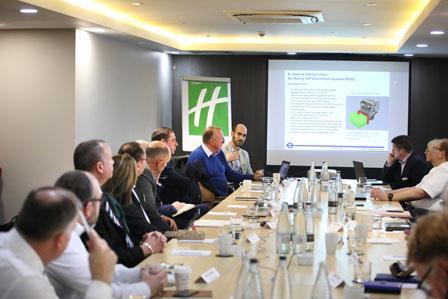
TfL is due to introduce phase 2 of its Direct Vision Standard in October 2024 and its consultation on the amended standard closed on April 3. Just before the deadline Motor Transport in association with Brigade Electronics held a roundtable debate with TfL and a group of leading operators to discuss phase 2 and its expected impact.
Steve Hobson, editor, Motor Transport: Welcome to this roundtable in association with Brigade Electronics. We will start with short presentations from TfL, Brigade and DAF on the proposed revisions to the DVS.
Dr Polyvios Polyviou, strategy and planning manager – freight, TfL: The DVS was introduced in October 2019 but enforcement was delayed until March 2021 due to Covid-19, and we made a commitment then to raise the minimum requirement from one star to three stars from October 2024 after consulting with industry.
Compliance has been good with 244, 892 permits issued as of March 2023 and average daily scheme compliance rate at 94%. We have seen a reduction in fatalities as a result - fatal collisions have halved since 2018 and serious injuries are down from 39 in 2018 to 17 in 2021.
Jacqui O’Donovan, MD, O'Donovan Waste Disposal: We have gone from 39 in 2018 to 17 in 2021 but the DVS only started in 2021 so the reduction wasn’t because of the DVS. Is that all HGVs?
Polyviou: Yes those are for HGVs and this is showing the trend going down over the last few years. We feel some part of the reduction was due to the DVS.
O’Donovan: Do we have the data on what star rating the vehicles involved were? I think that figure is distorting everybody’s view because while it has halved it isn’t because of DVS.
Polyviou: Yes that’s a fair comment that the comparison goes beyond the DVS introduction in 2019 and there are more stats publicly available on our website for specifically the first year of operation. We have looked at accidents since enforcement began and they are still going down.
Sam Weller, principal city planner, TfL: We are now monitoring the star rating of vehicles and whether the incident was vision-related so going forward we will have better visibility.
Polyviou: So why do we need phase 2? The original Safe System was developed in 2018/19 and it was our policy commitment to review and consult on it and increase the minimum direct vision rating to three stars. This aligns with the London mayor’s wider Vision Zero which is to have by 2041 zero deaths across the network.

There is more to do because zero-star vehicles accounted for four of the six fatalities in 2021 where vision was cited as a contributory factor by the police.
Based on our learned experience from phase 1 and improvements in technology we commissioned Loughborough University to undertake a review and provide recommendations to us which we used to put forward our proposed Progressive Safe System.
Chris Cooling, senior transport manager, Day Aggregates: Do we know what is the representation of zero star vehicles in the vehicle parc?
Polyviou: I would estimate that of the 250,000 vehicles with permits around 60% would have zero stars.
Cooling: So the four out of six involved in fatalities is a bit misleading.
O’Donovan: Are you saying the accident happened because of the blind spots on the vehicle or that the four out of six just happened to be a zero-star vehicle? We want to progress but only in the right way and to do that we need the full picture.
Garry Lewis, transport standards manager, Tarmac: Two thirds of the fatalities are due to two thirds of the fleet out there so a third of fatalities are due to one- to five-star vehicles.
Polyviou: You are all familiar with the existing Safe System (below) which has been applied to all zero-star vehicles and details are on the TfL website. The proposed Progressive Safe System will be applied to all zero-, one- and two-star vehicles.
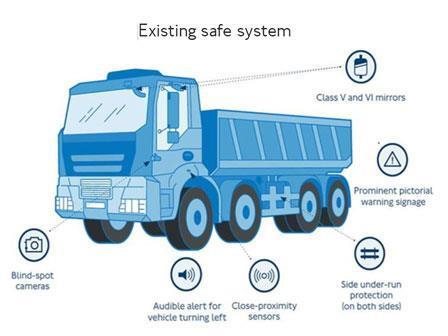
Weller: The proposed Progressive Safe System will require either Class IV, V and VI mirrors or a mirror-replacement camera monitoring system (CMS) or a combination of both.
The Class IV, V and VI mirrors are now pretty standard on most trucks to improve indirect vision but we have the CMS which are available on Mercedes and DAF trucks. So we are looking at accepting either the mirrors or CMS which after talking to people are probably better than traditional mirrors because they remove the mirror arm and mirrors to get rid of that blind spot at roundabouts and there is also a benefit in that on articulation the camera will follow the trailer.
One change is that instead of saying CMS ‘should aim to’ eliminate the remaining vehicle blind spot at the nearside the proposed regulation will say ‘must’. Another new paragraph defines ‘blind spot’ as ‘the area of the road that cannot be seen by looking forward through the windscreen or by using rear view mirrors’.
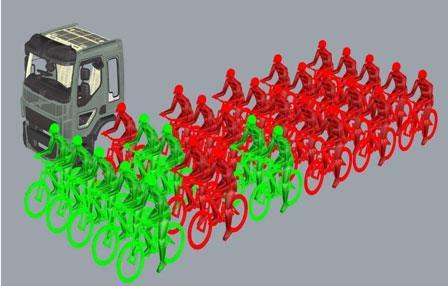
Research by Dr Steve Summerskill at Loughborough University has shown that all those in red (right) cannot be seen directly from the cab. Clearly there is an issue there and we need to eliminate totally the blindspot down the side of the vehicle. At the moment some cameras do, some don’t.
Mike Bennett, legislation engineer, DAF Trucks: When are you going to define the ‘blind spot’? Is it 4ft from the truck? 100ft from the truck?
Weller: This time we will look to put it in the specification to say the CMS must detect a certain range and cover this area.
Steve James, senior transport manager, FM Conway: I find that diagram very misleading. That appears to show that the bikes in red are invisible to the driver. You are endorsing Class IV, V, and VI mirrors that enable him to see what is there.
Weller: Yes I agree but there is still lots of evidence that people creep up the nearside and don’t get seen.

Moving on to side sensors, we have had some feedback on this already. On rigid vehicles the sensors must ensure full coverage down the nearside of the vehicle and a lot of people have done this already which is really good. It is a recommendation at the moment but will become a requirement to cover the whole of the nearside for all vehicles particularly the MG3 tippers where the driver is high up and has the blind spot problem.
For articulated vehicles the consultation says sensor systems must ensure full coverage of the nearside of the tractor unit and in addition the semi-trailer and that sensors must be suitably positioned to provide sufficient coverage but preventing activation solely on articulation of the trailer. We have had a lot of feedback on this mainly because a driver on a shift could potentially tow a couple of different trailers so what we are looking at doing – and this is only a maybe – is recommending something like radar or AI technology fitted to the tractor unit so it doesn’t matter what trailer you are towing.
There is technology out there that fits on the mirror arm or cab that can cover the whole of the nearside of the vehicle without having to fit anything to the trailer. We are well aware that drivers do trailer swaps and some trailers are not compatible because of the anti-roll system and ABS so this is something that will avoid connection difficulties.
We will accept the manufacturers’ statement that it is compliant with UNECE reg 151 at face value.
James Ashford, head of UK connected services, Brigade Electronics: Previously you would need two separate sensor systems because the technology to combine them was not out there. As the trailer jack knifes as it turns, the sensors on the tractor are fitted so far back they pick up the trailer which TfL wants to avoid. Our new Radar Predict will overcome this and is due to be launched in the summer.
Weller: That is why we want your feedback.

Carl Milton, cement logistics manager – UK, Cemex: We did trials years back and it is all about spacing the sensors. But radar technology on the tractor is going to supersede that and will leave the trailer independent because it is quite a task to have two side scan systems, one on the cab and one on the trailer. They would need to be adequately spaced because these things do have a range and they have to be compatible with the suzies.
Polyviou: That compatibility and practicality is a challenge and that is the feedback we are getting through the consultation.
Nigel Ponton, engineering manager, Cemex: Our next batch of vehicles are coming with the manufacturer’s radar system on both sides so we can move away from side scanners.
James: This works well with a straight-sided trailer but for operators with abnormal loads and low loaders it is probably going to be an insurmountable problem where the load is wider than the trailer body.
Milton: One of the issues today is that we are on the cusp of newer technologies and some of what you are requiring is leading edge technology in some ways. So as an industry we need time to let the manufacturers catch up. We first worked with Brigade back in 2001 developing side scan systems and that technology is quite aged now, and ultrasonics are giving way to radar, lidar and infrared.
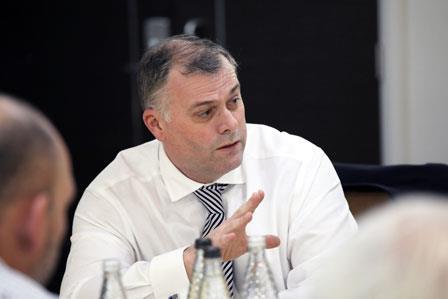
Weller: That is a proposal and something we are thinking about. We will listen to the feedback and make a decision later on.
Moving on, this is new – a mandated moving off information system (MOIS). There have been accidents at pedestrian crossings where the driver has not seen a person directly in front of the cab. Even with a two-star rating there is a blind spot – I know you have the Class VI mirror but if for some reason he didn’t look in that at least he will get an alarm.
It must be fitted in accordance with UNECE reg 159 and must be active not passive as with all the systems so when you drive past a bin it doesn’t activate. That would drive the driver mad and then he will just ignore it after a while. We only want the warning to sound when there is a credible risk of collision.
O’Donovan: If you are saying a driver might not look in the Class VI mirror for whatever reason he might not listen to the warning. The Class VI mirror is there to see those people.
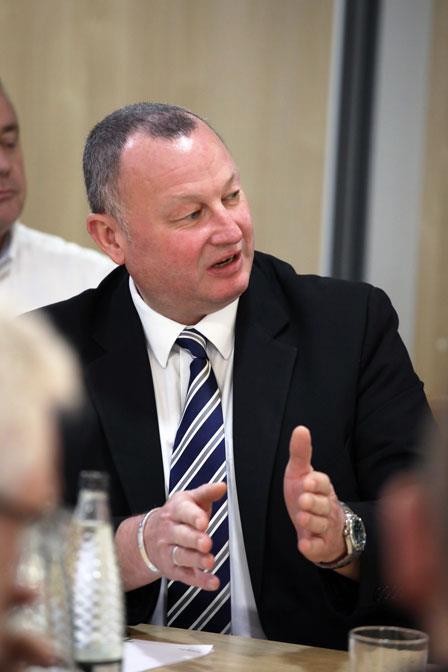
Ian Hartley, vice president operation - network transport and Tradeteam secondary operations: How do we expect a driver to deal with this amount of information? This in itself can become a danger. I can think of certain junctions in London where you would end up not moving because there are that many proximity alarms triggering in your cab. What we are asking drivers to deal with in urban situations, which are difficult enough, should be part of the consideration here.
Weller: That is why we have gone from passive to active [sensors] because we don’t want constant ‘pinging’.
Hartley: The drivers are highly trained to look in their Class VI mirror and we are almost trying to remove their ability to be professional drivers: ‘I can’t move because that alarm has gone off even though I can see everything is alright’.
Weller: I have driven a truck through London so I know what’s like. Sometimes you might not check your mirror before moving off for some reason and that is how fatalities can happen. This is a safeguard – I’m not questioning the drivers’ professionalism and I know what they go through. But this alarm is a failsafe that may just save a life.
Lee Anderson, transport and assets manager, Menzies Distribution: If the driver is going to ignore the mirror why would they take notice of a proximity warning?
Cooling: You are just giving them more to look at it. Introducing another device isn’t the road to go down.

Anderson: I don’t think we give drivers enough credit. They do an advanced test, 35 hours of periodic training every five years, pre-employment driver assessments, post-accident assessments and they are constantly being monitored. We are saying we don’t trust the driver’s judgement despite all the training we give them.
Cooling: This device will appear in GSR [the EU’s General Safety Regulations] in 2024 and the vehicle parc changes naturally. You asking the industry to retrofit all of this seems pretty flawed to me.
Weller: You won’t get a choice in 2024 because when you order vehicles they will come with it.
O’Donovan: When a new truck comes with it, you can’t do anything about it, but if we go back and tell our drivers ‘we have to fit a sensor now because you might not look in your Class VI mirror’ they will ask us ‘do you know how long I’ve been driving?’
Polyviou: We are aware that sometimes drivers switch these systems off to stop them buzzing all the time. There is a danger of sensor overload which is something we need to consider but it is an additional safety measure to prevent accidents at the front of the truck.
Weller: As we all know the GSR2 regulations will come in soon if the UK government accepts them. But I’m sure manufacturers are not going to build a UK truck.

O’Donovan: We can all moan as much as we like in the consultation and we know we are wasting our time. What we say will not be taken into account and TfL will make its mind up what it wants so it’s irrelevant what industry says.
We have no problem progressing and if the manufacturers put it on the lorry, it comes with the lorry. But retrofitting – here we again with you telling us we have to fit more things again when we already have a Class VI mirror.
Bennett: You’re quite right Jacqui. One problem is that when we replace mirrors with a camera system you don’t get a Class VI mirror, you get a MOIS or an additional camera that takes away the need for it. The other problem is if you’ve read reg 159 it is not achievable by the aftermarket. That is regulation that covers homologation of new vehicles.
Milton: It is interacting with the other vehicle systems so to retrofit things like interactive radar systems is inordinately difficult. As ABA4 [Mercedes-Benz’s Active Brake Assist] comes in it will not let the vehicle move off or it will put the brakes on so a lot of this technology is in the pipeline. But trying to bring it forward too quickly is in danger of hobbling the market. If this came in in London a lot of transport wouldn’t be able to run. We are waiting to trial a very advanced camera system from Austria but we are waiting months to get the parts.
Weller: Is there a problem with parts at the moment?
Cooling: Yes a huge one. This sounds like the same rush to retrofit we were promised we wouldn’t get in phase 1. It was a car crash first time around – we couldn’t get the kit or anybody to fit it. We are heading into the same rush here that we endured before and were promised faithfully we wouldn’t get.
Lewis: If we are taking about retrofitting 165,000 vehicles in 16 months that is 10,000 a month.
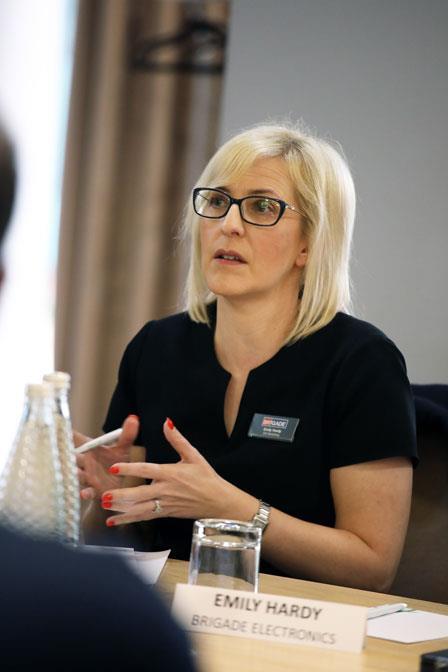
Emily Hardy, UK marketing manager, Brigade Electronics: We are recommending in our consultation feedback that TfL looks at some of the systems out there being honoured for longer because if people are putting vehicles on the road at the moment and fitting the equipment do they have to strip it off by October 2024 and replace it? And GSR is about whole vehicle homologation and there is a way to have systems that meet requirements at component level but it depends on exactly what you’re asking for. It isn’t going to meet the same requirements as GSR, it would only meet sections of it.
Ashford: DVS started on March 1 2021 but an extension was offered up to May because it was recognised there weren’t enough fitters available. That isn’t going away – if anything we have lost more fitters. It is a concern and we are aware of certain operators who couldn’t take their vehicles into London after May because they were still waiting for fitment.
Milton: Getting it installed is one thing but these are not fit and forget systems. Sensors and cameras fail and we have vehicles off the road for two weeks waiting for repairs.
Ashford: It is great having this new technology but do we have the fitters out there with the expertise?
Hartley: And do we have the driver trainers out there to train the people who then have to use this in their day to day jobs?
Ponton: Some of us use smaller third party haulage and this stuff is expensive for those guys. At the moment with the current systems they can go out and buy it on eBay and fit it themselves. Doesn’t mean it’s any good but it ticks the box. That isn’t going to be possible with some of this kit – for the right reasons.
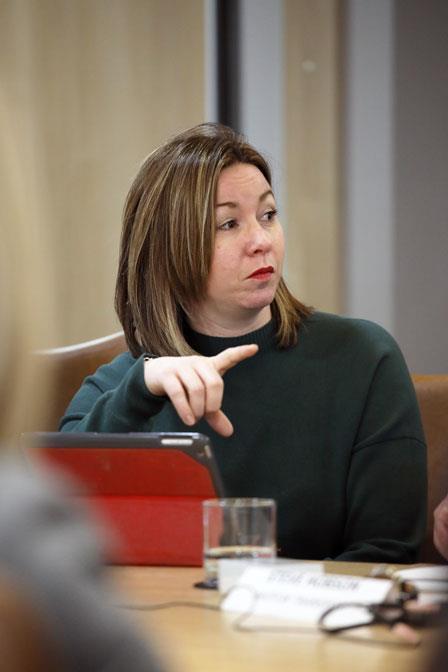
Natalie Chapman, head of public affairs, Logistics UK: It is really important that if businesses are making this investment that it is safe and effective and actually improves road safety rather than contributing to driver distraction. For the current Safe System you can buy cheap kit, poorly fit and maintain it, don’t train your drivers and potentially create a worse road safety risk. Reviewing the Safe System and upping the standard is good in principle but one thing I am concerned about is that we don’t know is what proportion of sensor systems are passive rather than active and therefore how many of the systems that are being fitted in good faith will have to be ripped out and replaced?
Milton: I would say the vast majority.
Chapman: Has that cost-benefit analysis been done on the impact it is going to have on industry? Lots of fleets have been fitting this kit even before DVS, whether that’s for FORS or just to do the right thing, and to say ‘sorry, your heart was in the right place but you have to rip it all out and replace it at huge additional cost’ sends the wrong message. Yes up the standard but do we confine it to new vehicles so if you’ve already got systems fitted and have a permit can you continue to run it for the life of that vehicle because it is a significant investment?
Polyviou: We don’t know exactly how many active and passive systems there are out there and that is a question we are asking but we have an indication from the operator survey we’ve shared that some of you have filled in for this work.
Weller: When you apply for a DVS permit you don’t have to declare whether it is active or passive.
Hardy: We have been marketing our latest generation system [SideScan Predict using predictive algorithms that only warns the driver if a collision is likely] for about a year.
Milton: Brigade are at the forefront of this so I guess 95% of the marketplace will be passive.
Lewis: The majority of the vehicles our hauliers are ordering now still have passive systems. Active systems aren’t part of our standard spec and hauliers are asking if the Volvo system will meet the requirements. We are saying ‘put money aside because it looks like it won’t meet the requirements’ yet this is OEM-fitted equipment that is better than a lot of the cheap aftermarket stuff on eBay. We are heading towards what could be a big mess if we aren’t careful.
Weller: Reg 151 is coming in 2024 – what part of 2024?
Bennett: June 2024 but we will be providing vehicles from week 45 this year that meet GSR2.
Ponton: No one is going to spend £10,000 on a vehicle that only has eight months’ life left.
Milton: Concrete mixer fleets are a good example. They are often run by small businesses and those vehicles probably only do 50 or 60 miles a day and they are quite expensive so they probably have a life of 10 years plus. If you bought a vehicle last year then that will still be in the market for another 10 years. Is there going to be a massive compensation scheme to compensate people for tearing out kit and replacing it?
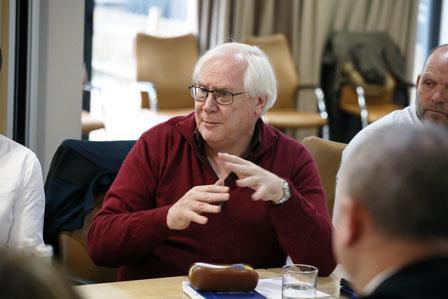
Lewis: Brigade can retrofit and turn a passive system into active but that is still another £1,000 to £1,500 to make that transition.
Ashford: It works for Brigade and their solutions but for other systems people bought in good faith you need something that takes into account what has already been done.
Milton: When the Brigade system went from analogue to digital a few years ago we had compatibility issues between tractors and trailers and had to change all the trailer side scan units to digital to match the cabs. Then we had to change all the suzie cables so that was a massive issue.
Ponton: Financially this could be an absolute horror show. You are talking about making it very difficult for people who are already struggling to make a living.

Milton: For most of our hauliers the return on capital is in single figures so any investment for those small to medium size businesses will be difficult. It is still the last unconsolidated haulage sector in the UK.
Lewis: Out of 1,600 trucks we have 400 who are one-man bands.
Hartley: Even for large operators like DHL Tradeteam this just makes everything on the shelves more expensive for the population of London. We will have to pass the costs onto our customers who then put it on the price of a pint of beer. All of it will end up eventually costing the public more money. For DHL alone this is a seven-figure problem so as an industry it is many millions of pounds.
There is also a danger of fragmented schemes in different cities so we will end up with a fleet that is fit for London but not fit for Birmingham or Manchester. That is the big danger five years down the line.
Cooling: It is bordering on becoming very niche. With the GSR on the horizon that will be pan-European we will be paying £3,000 or £4,000 a truck more whether we like it or not. But that’s fine because it will be a standard vehicle for the entire UK and Europe. Why you would continue to peddle this over something like that is a bit of a puzzle to me. All you are doing is increasing the cost to serve across the board and that will just filter through because in the end we will all have to pass it on.
Lewis: One big thing that FORS managed to do was simplify the safety standards for trucks – before FORS Tideway wanted this and Crossrail wanted that. We got that down to a single set of safety equipment and this is moving away from that ethos and defeating what FORS did. I am leading the GSAG group which is looking at FORS version 7 to try and bring these things into line but it is a nightmare trying to get the wording right so we have a single standard that works for London and Glasgow or Inverness.
Weller: There will come a point where you can’t fit any more stuff on a truck. The direct vision from the cab is the key component.
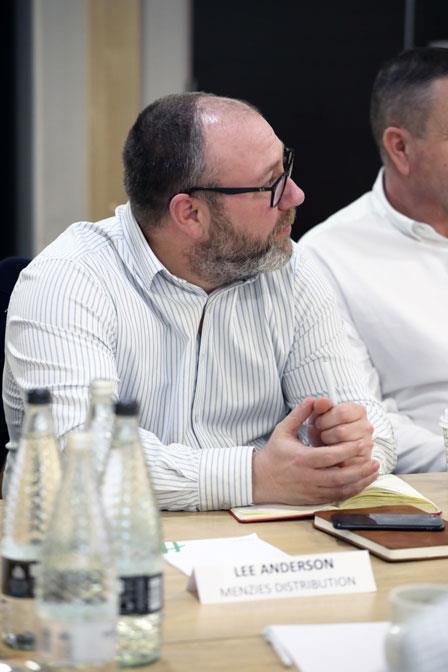
Milton: The biggest gift you can give a driver is better direct vision. The downside of more efficient engines is that the intercooler got bigger and bigger and the cab got higher and higher. We are seeing the reverse of that now. But we have seen fatalities in London where people have walked out in front of the truck and been driven over.
Polyviou: We have to strike a fine balance between adopting new safety technology and hearing all the concerns about cost. We are fully aware of the fine margins the industry is operating on. There are elements that are not in this consultation that we have introduced on buses over the last few years. I understand you feel this might not go in the right direction but I can reassure you that we will go through and analyse all the responses to the consultation, consider them carefully and respond.
Weller: There will be no changes to sideguards or warning signage. We are also looking at the user experience when it comes to applying for permits based on the feedback we have had from industry. We recognise there are a couple of issues and want to make the process easier.
Chapman: There are a couple of existing issues, one of which should have been in place when DVS first came in, which was a look-up tool. At the moment if any operator wants to find out if any one vehicle on their fleet has a permit and what star rating that vehicle is, they have to plough through their emails.
What they want to do is type in the vehicle reg number and see if it has a permit and the star rating. What we hear from operators is that if in doubt they just put another vehicle permit application in.
The other aspect that is really frustrating is the photographic evidence. It causes a lot of delays but I’m not sure what purpose it serves. The expensive bit of kit like the sensors, cameras and alarms are not identified – it’s the mirrors, side underrun protection and the stickers. If you were a real cowboy there is nothing to stop you taking the photos and removing the kit so what’s the purpose? It is just putting in a load of admin upfront for operators and TfL and what you could do is what the traffic commissioners do for O-licensing and allow self-certification.
The other issue is the upload time for DVLA data – operators are constantly bringing new vehicles into their fleets and if they have the minimum star rating or are fitted with a Safe System they shouldn’t be keeping that vehicle off the road for a week or two because there is an admin issue. Perhaps there should be a period of grace to bring a new vehicle in as long as, if it is stopped, it has all the equipment fitted.
There just seems to be a lot of unnecessary admin and operators need to be given a bit more trust.
Polyviou: There are few issues we are currently looking at including linking with FORS in the future to make that more effective. I can’t comment on those now as there is a still a live conversation on some of these issues but I am 99% certain there will be a look-up tool.
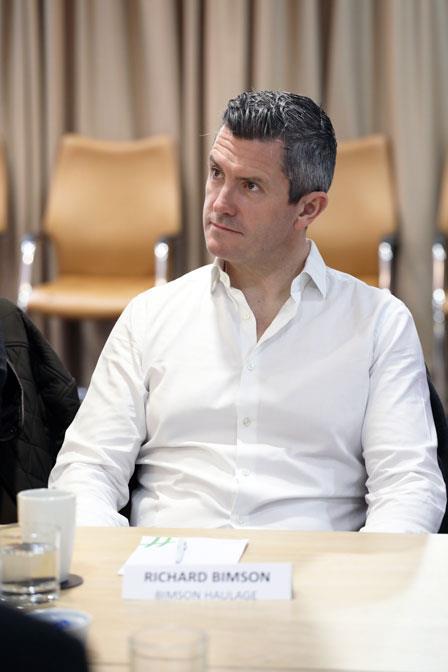
Richard Bimson, MD, Bimson Haulage: How much does TfL spend on direct vision? The reason I ask is that this is a two-sided debate. We are looking at it from a haulier and driver perspective and everybody here wants to do everything we can to improve safety. What is the mayor of London spending to educate vulnerable road users about HGVs? My children have not had a single hour of education regarding the dangers presented by HGVs on London roads.
Polyviou: A good point. We have a whole team working on VRUs and cycle safety and they do a lot with industry. They go out to schools and I can give you a list of examples.
O’Donovan: In road safety week we go out to a school each day and they have never seen anybody else.
Nick Simmons, CEO, RoadPeace: RoadPeace is a member-led charity for road crash victims and they campaign to make sure no one else goes through what they have been through. Education is an important part of that but getting the message across is difficult. People don’t think about this enough and don’t always engage in the conversation but when they do it is incredibly powerful. TfL are playing a very responsible role here.
Hobson: I would now like to introduce James Ashford from Brigade Electronics to tell us more about what the proposed Progressive Safe System might look like.
Ashford: The current Safe System requires proximity sensors, left turn camera, in-cab audible system and left turn audible alarm. Brigade classes all our sensor systems as active rather than passive because they give a warning to the driver and do not depend on the driver having to look at them.
The proposed changes will involve quite a significant investment and while no one is in any doubt that the technology will be of benefit we have to balance the cost versus benefits.
From 2024 the nearside camera must eliminate blind spots, active sensor systems must be fitted to semi-trailers, sensors on rigid vehicles must have a range of 2m and a MOIS must be fitted with a range of 2m in front of the vehicle.
The front sensor system must be reactive so as not to produce false alerts and must provide an additional signal when a collision becomes imminent, such as when the vehicle accelerates from rest and a pedestrian or cyclist is directly in front of the vehicle.
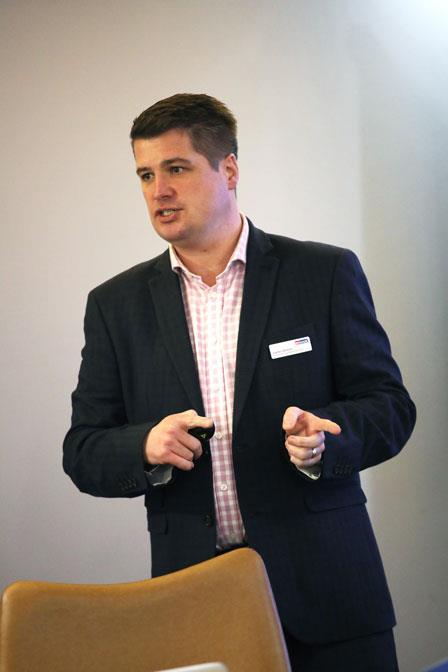
There is technology out there using AI cameras to detect and recognise human beings but these are dependent on the driver looking at the screen. This technology works but we need to think about the impact on the driver.
On rigids the requirement will be that sensors do not pick up street furniture and that is something that was an issue with the old side detection systems particularly if the sensors were positioned quite far back.
We do have an AI-led side detection system which eliminates a lot of the issues put forward by TfL. It is always on if the vehicle is doing more than 20mph and can differentiate between static and moving objects. It will also intensify the audible and visual warnings to the driver as an object moves into the danger zone and a collision becomes increasingly likely.
On artics, sensors must ensure full coverage of the nearside of the tractor and the trailer with a range of 2m of lateral coverage. There are new technologies out there including our Radar Predict launched in April that can be fitted on the nearside of the tractor near the fuel tank and look down the whole length of the vehicle including trailers. Technology is coming on in leaps and bounds and installation time is around two hours as opposed to six to seven hours for a traditional side scan system.
There are areas of concern that we have highlighted in our consultation response. The first is the GSR regulations 151 and 159. TfL mentions a 2m range but reg 151 contradicts that and says 4.5m so that needs to be cleared up.
We have concerns about how trailers are identified. It is easy with a truck because it has a number plate but a trailer will be interchanged and used with different vehicles so how do you police it?
Also everyone in this room has fitted a Safe System – do they have to rip it all out and start again? What are the cost implications behind that? Fitment backlogs are also a concern across all Safe System manufacturers – last time there was a two-month delay but it wasn’t quite long enough. That puts people under pressure and then they are more prone to make mistakes. We need to make sure the time lines are correct. We suggest looking at a phased approach with new vehicles first and existing vehicles which already have some equipment fitted afterwards. We really need a clearer idea of the technical specifications after the consultation has closed and what is required so everyone is on the same page.
Lewis: I was with SM UK [vehicle safety system installation specialists] on Friday and they were talking about how some of the in-cab warnings have the potential to be voice rather than bleepers and buzzers. This could tell them where they need to look. Is this on your radar?
Ashford: Good point but if someone’s first language isn’t English is that going to be a problem? For us the audible warnings are universally recognised.
Hardy: There is an alarm strategy in GSR. In TfL’s proposal you are looking at two alarms for the MOIS but in our response we propose just one to prevent driver overload and driver distraction.
O’Donovan: Two metres down the nearside – in London there will be people walking down the street and it will be picking them up because the kerb is so close. No matter how intelligent it is, even at 1m it will keep going off.

Ashford: Our current side detection systems operate with a range of between 1.5m and 2m. The vast majority of operators ask to have it reduced down from 1.5m because of false alarms from street furniture.
Lewis: It’s not just people – 2m will take you right out the building on the other side of the pavement.
Ashford: It’s a good talking point – is 2m too much?
Weller: That range came from Loughborough University’s research and testing.
Milton: I know where 2m comes from – it is the reaction time the driver needs once the alarm goes off. But in a busy city centre you are going to get a lot of false positives. The Loughborough trials were done very thoroughly to test how good these systems are practically.
James: They came out in our vehicles and sat next to the driver to witness the actual environment. We are still in the midst of a driver shortage in the UK and this environment we are creating for people who sit in a cab for nine hours a day with these constant alerts is going to increase fatigue for existing drivers. Will this encourage more drivers into the industry? Imagine sitting at your desk for that period and having alert overload. This is not going to aid our recovery from the driver shortage.
Hobson: I would now like to introduce Mike Bennett from DAF Trucks to give the OEM view.
Bennett: DAF Trucks in market leader in the UK with a share of 31% which means we have the biggest pool of vehicle that require certification or equipment.
Since 2019 we have provided 25,000 individual certificates of star ratings as well as providing details of over another 150,000 vehicles via mass uploads to TFL. The problem there is that we supply that data as a VIN and a star rating which is what TfL has asked for. However when you go to look for your vehicle on the system it will ask you for the vehicle registration number which we as a manufacturer are not especially interested in.
Part of our request to TfL is that the look-up data is in line with the data they are requesting from us. Every vehicle is uploaded when we get a certificate of conformity but every day I get at least 20 enquiries saying ‘my vehicle is not on the system’. It is – but not under the registration mark so we end up doing twice as much work. We don’t want customers to wait eight weeks for the DVLA and TfL data to correlate so you can get your permit. So we have asked for a grace period of six to eight weeks so the data can correlate.

TfL’s current online tool is not fit for purpose and needs a complete overhaul. We as a manufacturer have invested heavily so we can provide the right data to TfL and it is very disappointing when we get customers every day saying that information is not in the TfL database when we know it is.
Our 2017 vehicles which are the most common on the market at the moment primarily score zero stars as they have a conventional design with a high drivers’ seating position – though some LFs could score one or two stars. Many of these vehicles will remain in operation as we move towards the Progressive Safe System and will not be compliant even with their Safe System equipment because the new certification scheme for additional equipment will not be retrospective. So we expect many side sensor and camera systems will need replacing or re-certifying.
The New Generation DAF was introduced in 2021 with a view to both the GSR2 standards and the TfL DVS scheme. Most can meet three stars and some five stars. We have a UK-specific 4x2 tractor unit based on the XD that is the only vehicle in the industry that can achieve five stars without a low entry cab. There is a 1% to 2% fuel economy deficit but in an urban environment fuel economy is always going to be affected anyway.
The XG flagship truck can achieve two stars but will need additional equipment to meet the Progressive Safe System. As we move to GSR2 the vehicle will already have the necessary equipment fitted from the end of this year and we want to make sure GSR2 and the Progressive Safe System are aligned because we do not want to be fitting even more equipment on top of the GSR2 requirements.
The LF too can only achieve two stars but we will start fitting the GSR2 compliant equipment from November this year. The UK DfT is somewhat behind in implementing EU rules into UK law so we don’t expect it to be at the same time but we would like DVS to be in parallel with GSR2 as that just makes common sense.
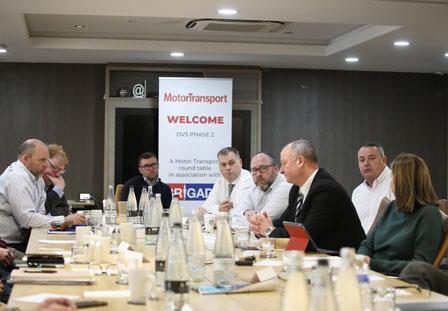
We estimate there are at least 211,000 vehicles with permits which will expire in October 2024 and every operator will have to reapply for a permit by showing the vehicle is rated at least three stars or has a Progressive Safe System fitted. It will be really difficult to do that in 16 months.
Currently aftermarket components can’t meet the requirements of reg 151 or reg 159 of the GSR2 so must be deemed as non-compliant with the Progressive Safe System. One of the biggest downfalls of the previous system was that it didn’t have a standard and we need some sort of standard so people can’t just buy cheap Chinese kit to fit to their trucks. That equipment won’t come with a certificate of compliance from the manufacturer whereas the likes of Brigade and DAF will have to guarantee it is compliant and stays compliant.
What about cost? TfL’s own impact assessment puts the cost to operators at anywhere between £135m and £1.48bn which is an unbelievable cost. There has to be some way of staggering the implementation process to enable the industry to support that level of cost. Nowhere in your impact assessment did you consider the effect on manufacturers which was very short-sighted.
There are also issues with component and workshop availability and I know one operator who has at least one truck a day off road because a sensor doesn’t work.
There is going to be an issue with cognitive overload for drivers. We are putting massive windscreens in our trucks but no one will be looking out of them because they will be looking at different screens. The focus really should be on the drivers, what they are capable of, how they are trained and the quality they provide and I think this has been missed in nearly all of the information TfL has put out.
James: Those costs from TfL are just direct costs and don’t include indirect costs such as vehicle downtime waiting for parts and technicians. You can’t quantify that and that is where it falls down. The tech shortage is the new driver shortage and we are reliant on a small pool of people to install all this equipment in a short space of time.
Bennett: We are bringing in 120 apprentices a year for our network of 137 dealers, so the technician shortage is a real concern.
Polyviou: This was not a TfL impact assessment, it was done by an independent consultant commissioned by TfL and they were in touch with industry, and some of the people in this group have fed into this, to quantify the costs.
Karl Wilshaw, fleet director, Travis Perkins: Will DAF’s current City Turn Assist radar system meet reg 151?

Bennett: No but the GSR2 system will. City Turn Assist is a German product that only has the TUV approval not UNECE approval. While it meets the current requirements of the DVS it shouldn’t meet the three star standard. So vehicles in the market now that were bought with City Turn Assist as an option won’t meet GSR2. You can’t retrospectively certify equipment that has already been fitted to reg 151 because it is a whole vehicle homologation rather than an individual component approval.
Wilshaw: So at the moment DAF does not have a product that will meet the standard that is coming. Does Brigade have a product today which meets reg 151?
Ashford: We are working on certification to make it compliant.
Bennett: There is a proposal to bring retrofit equipment within reg 151 but it is not in writing at the moment. The way the rules are written does not include retrofit components but that will be brought in, probably as an extension to the approval.
Hobson: Thank you to our presenters and to everyone for taking part in the debate.













